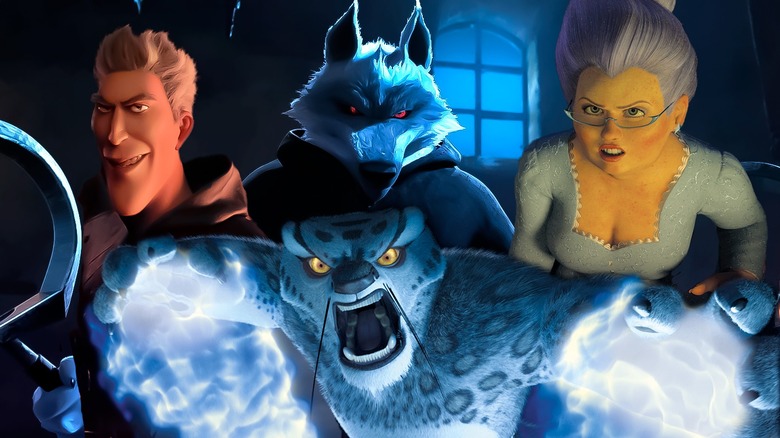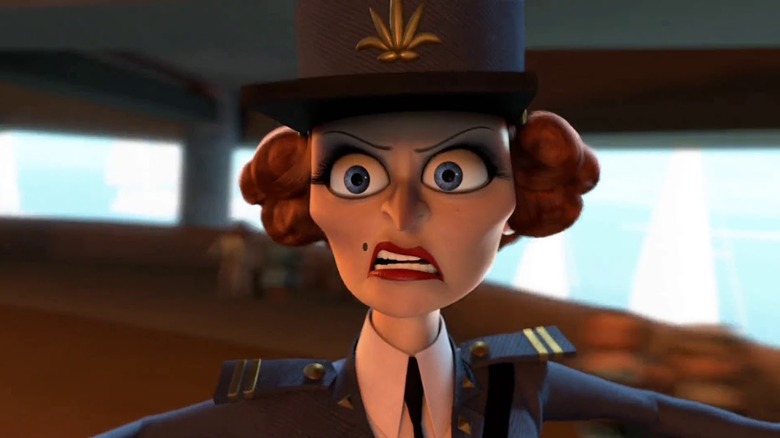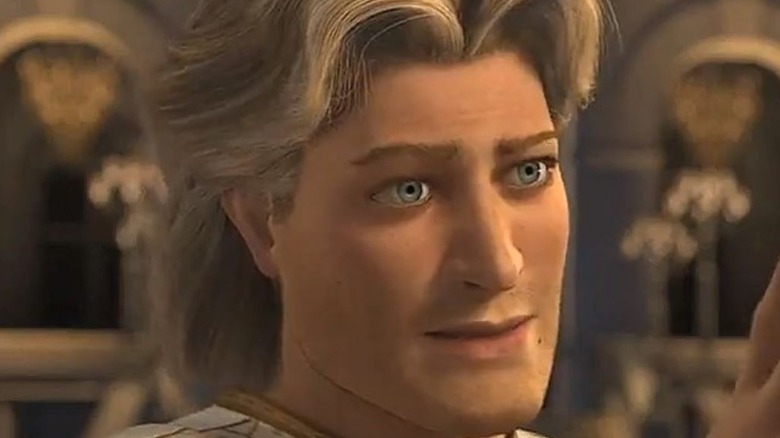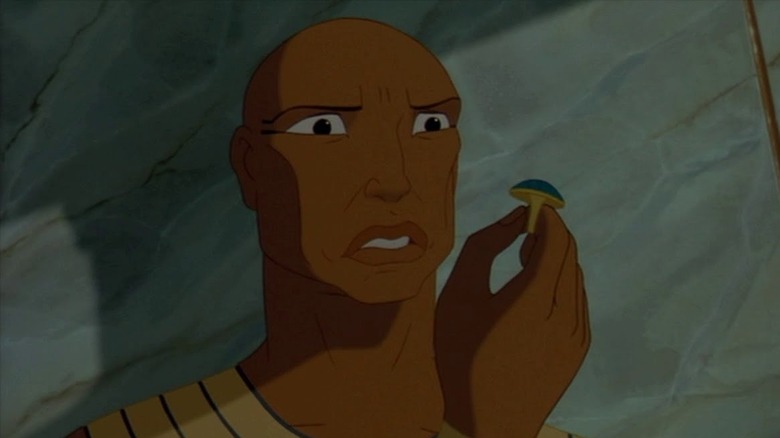The Best DreamWorks Animated Movie Villains Ranked
DreamWorks Animation may not match the acclaim and prestige of Disney, but nearly every one of their movies is worthy of some sort of praise. More often than not, DreamWorks' movies manage to delight viewers of various ages, with their sharp comedy, grounded emotional storylines, and likable characters appealing to younger and older audience members alike.
For the past 20 years, DreamWorks has steadily risen to the forefront of the animation industry, delivering movies that are financially and/or critically successful among mainstream moviegoers. Like Disney or Pixar, there are numerous factors accounting for DreamWorks' success, from vibrant animation styles to fantastic musical scores. When it comes down to it, though, DreamWorks films simply put gripping storylines first and foremost. And to propel these narratives, the studio employs a vast assortment of colorful main characters for audiences to bond with and root for, like the grouchy ogre Shrek or the kung fu underdog panda Po.
Still, a hero is only ever as good as their villain. Fortunately, DreamWorks has delivered no shortage of strong antagonists. Some may be more intimidating while others are simply comical, but they're often among things about the movies they appear in, proving themselves a worthy adversary to their film's main protagonist. From satirical subversions of fairy tale characters to unhinged potty-humor supervillains, here are some of the greatest villains in DreamWorks' animated films, ranked from worst to best.
15. Professor Poopypants (Captain Underpants: The First Epic Movie)
It takes quite a villain to live up to the grandeur of Captain Underpants. Thankfully, the nefarious Professor Pee-Pee Diahreeahstein Poopypants Esquire (Nick Kroll) more than rises to the occasion. A brilliant scientist suffering from an unfortunate name, Professor Poopypants (or "Professor P." as he prefers to be called) is the first real villain Captain Underpants faces on the big screen.
A talented inventor by trade, Professor Poopypants' accomplishments are perpetually overshadowed by his embarrassing name. His crowning achievement — winning the Nobel Prize — became a moment of crippling humiliation as the audience in attendance exploded into laughter upon hearing the professor's name said out loud. Since then, Poopypants has been hiding, secretly attempting to develop an invention capable of shrinking the Hahaguffawchuckleamalus — the part of the brain responsible for laughter. By doing so, Poopypants hopes to create a world free from joy and laughter, where he'll be able to live in peace without anyone mocking him for his name.
There are many villains that the filmmakers at DreamWorks might've chosen for Captain Underpants' first movie, but few are as downright hilarious as Professor Poopypants. A clever spoof of a stereotypical mad scientist, the character's intrinsic humor and lightheartedness makes him a hilarious foil to the briefs-clad hero. If that weren't enough to like him, Nick Kroll's exaggerated German accent and Poopypants' random tirades and childish outbursts bring a lot to his presence.
14. Lord Farquaad (Shrek)
The original villain of DreamWorks' flagship franchise, Lord Farquaad (John Lithgow) was the perfect antagonist to tie into the satirical fairy tale presented in 2001's "Shrek." The fun of "Shrek" is that it openly mocks many conventions of age-old fables — especially those that were depicted in Disney's animated movies. What better inversion was there of princely royalty than the power-hungry, lecherous, and insecure Lord Farquaad?
A diminutive regional lord with a severe Napoleon complex, Lord Farquaad serves as the complete antithesis to the brave, kind-hearted, and gentle princes featured in Disney's movies. Arrogant, egocentric, and driven solely by his desire to rule, he has a hostile view of Duloc's magical population, banishing any inhuman creatures from his kingdom.
While not as formidable a foe as later "Shrek" antagonists like the Fairy Godmother or Prince Charming, there's a humorous air about Farquaad that makes him a wickedly fun villain. His relatively small stature alone provides the film with many of its funniest, most tongue-in-cheek jokes, along with Farquaad's obvious attempts to make up for it (whether it's erecting a massive castle or wearing a specialty suit of armor to appear larger than he is). He may not have as much presence as other villains on this list, but he's still a delightful villain that set the standard for every "Shrek" antagonist that came after.
13. Captain Chantel Shannon DuBois (Madagascar 3: Europe's Most Wanted)
As enjoyable as the "Madagascar" films have been, the series always lacked a truly intimidating villain who posed a serious threat to the main characters. At least, that was the case until "Madagascar 3: Europe's Most Wanted," which introduced viewers to one of the more dangerous and downright terrifying villains in the DreamWorks canon: Captain Chanel Shannon DuBois (Frances McDormand). A French officer in Monaco's Animal Control, DuBois is assigned to apprehend the animals roaming through Europe in the film, carrying out her assignment with the utmost gusto and enthusiasm.
Her first scene in the film tells you all you need to know about Captain DuBois — her personality, her motivation, and the twisted love she has for her professional responsibilities. Having developed a sadistic infatuation for killing animals when she was just seven years old, DuBois maintains a large assortment of taxidermy heads mounted on her office wall. Forever looking to add to her collection, DuBois uses her position in Animal Control to her advantage, giving her the opportunity to bag any new creatures who are unfortunate enough to catch her attention.
In pursuing the main characters of "Madagascar," DuBois is shown to enjoy the thrill of the hunt, pining after the fugitive animals with the enthusiasm of Kraven the Hunter and the singular determination of a Terminator. She may be far more comical than other determined DreamWorks hunters like Grimmel the Grisly or even Death, but she's every bit as relentless in her pursuit.
12. Humpty Alexander Dumpty (Puss in Boots)
It's hard to know how to describe Humpty Alexander Dumpty (Zach Galifianakis), the main mastermind behind the daring heist at the center of "Puss in Boots." The childhood best friend of Puss, Humpty embraces a criminal lifestyle while Puss opts for a life of adventure and fighting for justice. Abandoned by Puss after a robbery gone wrong, he spends years plotting his revenge against his former friend, using their past relationship to manipulate Puss into helping him steal away the coveted golden egg.
By the end of the film, Humpty undergoes a moral awakening that culminates in his redemption. Finally making amends with Puss, he sacrifices himself to save San Ricardo from the Great Terror, transitioning from main antagonist to a supporting protagonist by the movie's conclusion. As cathartic as Humpty's transformation is, his original presentation as Puss' longtime rival is a fascinating one, especially given how deftly he uses Puss' emotions to his advantage.
From his outward appearance alone, there's no question that Humpty is indeed a comical villain. The physical limitations of his body are enough to make anyone laugh (as seen whenever he falls over and needs assistance getting to his feet), as are his neurotic tirades and outbursts. Additionally, the revelation that he's been secretly orchestrating the quest to claim the golden egg is both brilliantly executed and utterly hilarious. While his redemption arc is a satisfactory end to his story, that doesn't diminish how excellent a villain he is for the second act of "Puss in Boots."
11. Big Jack Horner (Puss in Boots: The Last Wish)
In this day and age, it's not uncommon for villains in family-friendly movies to receive some kind of redemptive character arc, allowing them to transition from a tragic antagonist into a sympathetic hero by the film's climax. Breaking that relatively new convention in children's movies is "Big" Jack Horner (John Mulaney), the secondary antagonist of "Puss in Boots: The Last Wish."
A larger-than-life figure in more ways than one, Horner grew up embittered at his lack of magical powers, especially when compared to the other fantastical creatures around him. As the basis for the well-known nursery rhyme, "Little" Jack Horner grew up desiring to match the acclaim of other, more notable fairy tales. Overshadowed by famous fables like Pinocchio, young Horner wanted nothing more than to gain magical abilities to impress people, ultimately becoming a feared pastry chef with an obsessive love of folklore.
Compared to the Wolf who pursues Puss throughout the movie, Horner doesn't live by his own set of morals. His only ambition is to secure power, lording it over others and obtaining it at the cost of lives. Despite the humor tied to his character, he has no redeeming qualities, existing as an outright megalomaniacal figure in the same vein as other "Shrek" baddies like Lord Farquaad or the Fairy Godmother. That being said, he's also an ideal malevolent force for Puss and his allies to deal with, unlike the morally gray Three Bears Crime Family similarly pursuing the Last Wish.
10. Grimmel the Grisly (How to Train Your Dragon: The Hidden World)
Far and away the best villain in the "How to Train Your Dragon" trilogy, Grimmel the Grisly (F. Murray Abraham) is also the most dangerous enemy Hiccup and his friends face in their time together. A dedicated and skilled dragon hunter, Grimmel can be best described as the nightmarish mirror version of Hiccup. Stumbling upon a Night Fury as a boy, Grimmel quickly killed the rare dragon rather than bonding with it as Hiccup would years later, becoming a hero of his village in the process. Inflated by the praise of his community, Grimmel took to hunting dragons professionally, earning a reputation for himself the world over in the process.
As part of his desire to kill as many dragons as possible, Grimmel specifically delights in targeting the Night Fury species, having wiped out all of them save for two (Toothless and a white female Fury). Hired by a group of warlords to capture the pair — thereby commanding the remaining dragons of Berk — Grimmel begins tracking Hiccup and his bustling utopia of dragons, using his vast armada to chase them across the sea.
Merciless, unwavering, and unrelenting in his tactics, Grimmel hunts dragons with the same sadistic delight as Captain DuBois does zoo animals or Mrs. Tweedy does chickens. Using a slew of innovative and unethical techniques to track his prey — including drugging and brainwashing several Deathgripper dragons — he poses a serious mental and physical challenge to Hiccup and Toothless.
9. Titan (Megamind)
A resident of Metro City, Hal Stewart (Jonah Hill) is the hapless cameraman partnered with Roxanne Ritchi, a colleague for whom he has unreciprocated feelings. After the superhero Metro Man abruptly vanishes, his nemesis Megamind seeks to create a new adversary to spend his time fighting. Using Metro Man's DNA, Megamind accidentally channels superhuman abilities to Hal. Masquerading as a mysterious "Space Dad," Megamind trains Hal into becoming Metro City's protector, fulfilling the mantle left behind by Metro Man.
Donning the moniker of Titan, Hal's superhero career almost immediately fails when he realizes Roxanne doesn't share his romantic feelings, prompting him to go on a crime spree instead. Furious over being snubbed by Roxanne, Titan embraces the darker aspects of his personality, rampaging through the city with little remorse.
In many ways, Hal isn't exactly a bad person — he's just a man who, by all rights, shouldn't have inherited the powers and responsibilities that come with being a superhero. With his newfound abilities inflating his ego, he sees being Titan as a chance to finally accomplish something with his life, as well as a way to finally impress Roxanne. When neither of those things pan out, he resorts to using his powers for selfish gain, rather than actually using them to do good in the world or combat evil. In essence, he's like a family-friendly version of Homelander from "The Boys": an egomaniacal, self-interested "hero" who cares little for the greater good of Metro City.
8. Pitch Black (Rise of the Guardians)
The physical personification of fear, Pitch Black (Jude Law) is the ancient Boogeyman who stands apart from the other Guardians in 2012's "Rise of the Guardians." Where the others bring hope, warmth, and joy to humanity, Pitch Black brings only negative feelings like doubt, uncertainty, and fear. Relegated to a secondary role in a new age, Pitch Black seeks ways to destroy the Guardians' influence, once again ushering in an era of fear and darkness.
Owing to the fact that he's literally evil incarnate, there isn't much redeeming about Pitch Black's character, his sole motivation being to negatively influence humanity with his malevolent emotions. Devious, manipulative, and resourceful to no end, Pitch is capable of worming his way inside the minds of even the most powerful beings (including the Guardians), toying with their minds long enough to break down their mental defenses. At that point, he's able to target any psychological weaknesses that might exist, using his army of nightmares to exploit people's greatest phobias.
While he believes himself incapable of harboring human emotions, there are a few illuminating moments that shed light on Pitch's tortured inner psyche. While he mocks Jack Frost for his crippling fear of loneliness, Pitch himself admits to intense feelings of isolation, not enjoying the same inclusion as the Guardians. Rather than coming to terms with these feelings, Pitch buries them deep inside himself, sealing himself off emotionally and giving in to his hate.
7. Prince Charming (Shrek 2 and Shrek the Third)
Prince Charming (Rupert Everett) has the odd distinction of being the only antagonist in the "Shrek" franchise to appear in two separate movies. Depicted as a supporting antagonist in "Shrek 2" and later upgraded to the main villain of "Shrek the Third," Charming is a more overt satirical take on Disney's princes than Lord Farquaad. Handsome, dashing, and courageous to an extent, he's slated to rescue Fiona from her castle and marry into her family prior to the events of the first film (a plan established by Charming and his mother, the Fairy Godmother).
Upon discovering that Shrek has already saved the princess, Charming pieces together a scheme with his mother to separate Shrek from Fiona. By the movie's climax, their plot falls to pieces, with the Fairy Godmother accidentally taking her own life. Devastated by the loss of his mother, Charming returns in "Shrek the Third" seeking revenge, rallying traditionally antagonistic fairy tale creatures to his side to take up arms against Shrek and his family.
A spoiled, arrogant, and vain mama's boy, Charming is an entitled prince who insists on getting everything his way — only to lash out and whine whenever he doesn't. Having been handed everything in life, he grows up expecting everything to pan out in his favor, turned into a pampered man-child by the overindulging attention of his mother. With all that in mind, he's the perfect foil to Shrek, and arguably one of the most well-written characters in the "Shrek" series to date.
6. Tai Lung (Kung Fu Panda)
The original villain of "Kung Fu Panda," Tai Lung (Ian McShane) set a high bar for every antagonist in the franchise that came after. Abandoned as a baby in front of Master Shifu's temple, Tai Lung was Shifu's first student, excelling in kung fu under Shifu's tutelage and guidance. Believing himself skilled enough to be the Dragon Warrior (an assumption shared by Shifu), Tai Lung was crushed when Master Oogway refuted his claim, recognizing a darker side to the snow leopard's personality that Shifu had overlooked. Enraged by Oogway's dismissal, Tai Lung attempted to seize the Dragon Scroll by force, leading to his 20-year long imprisonment and permanent estrangement from his former master.
It's hard to blame Tai Lung for his ill regard for Shifu, Oogway, or Po by proxy. A relatable villain in some ways, he's comparable to Anakin Skywalker from "Star Wars" — a skilled warrior whose turn to evil is fueled by his superiors' mistrust of him. In an alternative timeline, it's possible to see Tai Lung as a mentor of sorts to Po, instructing him in the same way Shifu had when he was a boy. Sadly, Tai Lung's obsession with becoming the Dragon Warrior has led him down a sinister path of violence, betrayal, and self-aggrandizement.
5. Mrs. Tweedy (Chicken Run)
Mrs. Melisha Tweedy (Miranda Richardson) is among the most intimidating antagonists featured in a children's movie. Trapped in a loveless marriage to her husband Willard, Mrs. Tweedy owns a financially struggling chicken farm in northern England. Running the farm with the callous glee of a prison warden, the Tweedys have structured the farm like a well-run jail, complete with towering barbed wire fencing, vicious guard dogs that are always on patrol, and grueling punishments for any chickens caught trying to escape.
With her gaunt appearance, pale skin, and permanent frown, Mrs. Tweedy seems like the ghostly apparition of Death — an ominous figure whose mere appearance strikes fear in the hearts of her chickens. If her visage alone wasn't unsettling enough, her fiendish plot only adds another dimension to her ghoulish character. Tired of making miniscule profit, she tries to adapt her farm to an industrial meat factory, using state-of-the-art technology to butcher and bake a vast number of chickens into pie at once.
Grim, serious, and determined to yield some kind of income from her farming business, Mrs. Tweedy is a serious danger that the chickens of "Chicken Run" are desperate to escape. As passionate as she is in her hatred of the farm and the animals in her care, Tweedy's overconfidence proves to be her undoing. Underestimating the intelligence and resourcefulness of the chickens, she spends more time focused on creating her pie-making machine than anything else — although she comes incredibly close to massacring the entire farm by doing so.
4. Fairy Godmother (Shrek 2)
The best villain in the mainline "Shrek" series so far, the Fairy Godmother (Jennifer Saunders) is also the most cunning foe Shrek and his family have ever come across. As revealed in "Shrek 2," the Fairy Godmother is the primary person responsible for Fiona's imprisonment in the first film. Locking her up in the tower so that her son, Prince Charming, could save her, Godmother endlessly plots ways to have Fiona and Charming end up together, guaranteeing Charming's ascension to the throne of Far, Far Away.
Manipulating Fiona's parents (especially her father, King Harold) into aiding her plan, the Fairy Godmother spends the duration of "Shrek 2" trying to figure out ways to banish Shrek and set Fiona up with Charming. A classic subversion of the homely, wise fairy godmother figure seen in Disney's films (most especially "Cinderella"), she's a corrupt, twisted, and unethical sorceress who's more of a witch than she is a helpful spellcaster. The "Shrek" version of Dolores Umbridge, she hides behind a doting smile, colorful personality, and pastel color scheme, but in actuality is every bit as egomaniacal and entitled as her son, if not moreso.
There's no end to the amount of wrongs the Fairy Godmother is guilty of in the context of "Shrek 2." From relying on her powers to ensure Charming gets everything he wants to blackmailing those she's helped in the past (like Harold), she's an unscrupulous magic user who does far more harm than good whenever she appears.
3. Rameses II (The Prince of Egypt)
The first 2D animated film from DreamWorks, "The Prince of Egypt" is still one of the studio's most ambitious projects. Based on the life of Moses and the Book of Exodus, the film acts as a relatively light but still dramatic Biblical epic, palatable for children and older viewers. True to the age-old story of Moses, the movie draws on the legend of Rameses II (Ralph Fiennes) to create the main antagonist for the film.
The adoptive brother of Moses and the heir to the throne of Egypt, Rameses was raised knowing the full weight of responsibilities that would one day be bestowed upon him when he assumed the title of pharaoh from his father, Seti. Constantly chastised by his parents whenever he embarked on reckless antics with Moses, Rameses was instilled with a lasting belief in the power of tradition and legacy, as well as a paralyzing fear that he would become the "weak link" responsible for the erosion of his family's influence in the world.
As Moses' sibling, Rameses is shown not to be an outright evil villain like so many other entries on this list. Instead, he's more focused on cementing his family's hold over Egypt, challenging himself to live up to his father's insurmountably large shadow. Never acknowledging his family's flaws (such as their culpability in prolonging slavery), he's a misguided ruler whose headstrong belief in upholding the status quo makes him an enemy of Moses by pure circumstance. Not content to see reason or give into morality, his stubbornness only leads to great suffering for himself and his people.
2. Lord Shen (Kung Fu Panda 2)
The "Kung Fu Panda" series has seen its fair share of fantastic villains, but few come close to matching "Kung Fu Panda 2" antagonist Lord Shen (Gary Oldman). Once the heir to the peaceful Gongmen City, young Shen became obsessed with the city's newly-invented fireworks, studying them in an attempt to deduce how to harness their explosive properties. Banished by his parents after leading a massacre against the city's panda bear population, Shen grew into a warlord whose sole focus is on developing and using large cannons to conquer all of China.
It speaks volumes about the obvious talent of the filmmakers that they made a peacock appear genuinely threatening. As with Tai Lung, Shen's focus is on obtaining more power, albeit in a far different manner than the series' previous antagonist. A skilled combatant in his kung fu fighting abilities, Shen is able to recognize the limits of hand-to-hand combat, as well as the individual extent of his own martial arts prowess. Relying instead on advanced technologies to wage more destructive warfare on his enemies, Shen is one of the most unconventional obstacles Po and Furious Five encounter.
Recognizing the devastating effects of gunpowder, Shen is an advanced strategist who transcends the physical abilities of Tai Lung and Kai from "Kung Fu Panda 3." A brilliant tactician with an ingenious strategic mind, he's graceful in his kung fu, curt in his manners, and confident in his ambitions to rule an entire continent.
1. The Wolf/Death (Puss in Boots: The Last Wish)
Is Death (Wagner Moura) a traditional villain along the same lines as Lord Shen, Mrs. Tweedy, or the Fairy Godmother? No, not at all. But given his antagonistic attitude towards Puss in Boots, it's hard to describe him as a strictly just character. The de facto villain of "Puss in Boots: The Last Wish," the Wolf is the physical incarnation of Death, taking lupine form to pursue our hero.
Insulted by the fact that Puss has nine lives — eight of which he's frivolously wasted — Death seeks the retribution of taking Puss' ninth and final life. Shrouded in a black cloak and announcing his presence with an eerie low whistle, Death is not only the best villain in the "Shrek" extended universe; he's the best DreamWorks antagonist of all time.
Despite his threatening appearance and obvious ill regard for Puss, Death's motivations are strictly neutral. He feels rightfully slighted by the cat's haphazard disregard for life, and is interested mostly in teaching him a lesson. According to Death's philosophy, to truly value life you need to live each day as you would your last, giving the prospect of mortality the respect it deserves. All of this makes Death a uniquely memorable character. He lives by his own set of morals and rules, following them stringently and ultimately helping Puss grow more humble and appreciative of life in the process.















